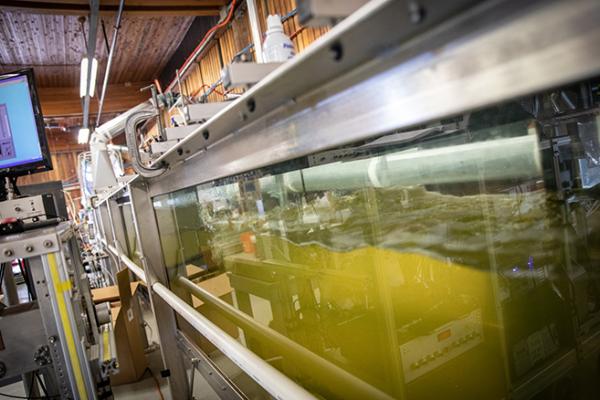$20 million NSF grant continues groundbreaking climate change research

What impacts do aerosols have on cloud formation, critical atmospheric processes and global climate change?
The Center for Aerosol Impacts on Climate and the Environment (CAICE) and its interdisciplinary team of researchers from universities around the U.S. are working hard to find the answers. And with a new five-year, $20 million grant from the National Science Foundation (NSF), CAICE is set to continue shedding light on how sea-spray aerosols interact with the atmosphere. The grant is a renewal of an initial five-year, $20 million grant awarded by NSF in 2013.
The Intergovernmental Panel on Climate Change has for years considered aerosols the biggest uncertainty in climate change modeling. CAICE researcher Heather Allen, professor in the Department of Chemistry and Biochemistry, conducts research that is vital in unraveling the complex climate change equation.
CAICE, which consists of a group of scientists that include chemists, oceanographers and biologists and is led by the University of California, San Diego, works to understand aerosols that are ejected from the ocean, one of Earth’s largest natural aerosol resources. The miniscule liquid particles, which have a wide range of chemical variability based on an array of oceanic and atmospheric factors, react in various ways with gases already present in the air. By studying these interactions, scientists can better understand how aerosols influence temperature variation, extreme weather events such as droughts and floods, and climate change.
“The theme is bringing together very fundamental chemistry all the way to very applied chemistry and tackling very specific questions that we hope to make a difference for climate change modeling,” Allen said.
Allen joined CAICE in 2013. Her specific research focuses on using specialized laser equipment that gathers molecular properties from the water surface to understand the surface’s structure. The structure and chemical makeup of the ocean surface, which is micrometers (or thousandths of a millimeter) thick, is vastly different than that of the ocean’s whole. Understanding chemical activity of the surface of the ocean and the surface of individual aerosol particles is key to deciphering the profound impacts aerosols as a whole have on climate.
One primary contribution Allen and her team of graduate students discerned was discovering that the surface layers of both aerosols and the ocean were less acidic than their bulks. The team also discovered that surface molecules bond strongly to metals like zinc and iron, which leads to a higher concentration of trace metals present in surface layers.
What kind of implications do these relationships and interactions have? Allen routinely collaborates with other CAICE researchers to brainstorm and form questions based on their findings.
“I’m learning from everyone else,” she said. “Collaboration really does stimulate how you think about an experiment to answer a question.”
This latest NSF grant will help develop queries and the experiments to resolve them. The next phase of CAICE research includes reproducing realistic sea-spray aerosols, including the biology, and introducing them to sunlight, high winds and air pollution to determine how the resulting interactions change the atmosphere’s chemical composition. CAICE utilizes a state-of-the-art, 3,400-gallon wave tank at the Scripps Institution of Oceanography in San Diego to replicate the ocean and its conditions. A new wind-wave channel coupled with a specialized smog chamber is currently under construction and will be completed in 2020. Upon its completion, CAICE scientists will be able to introduce outside pollutants, generate high winds and control air and water temperature to mimic real-world ocean-atmosphere dynamics as closely as possible.
“With climate change, there’s been a subset of researchers that have been trying to understand the aerosol contribution — whether it be positive or negative,” Allen said. “If you start out with very molecular level processes, you can imagine all kinds of experts in lots of different areas can contribute.”
